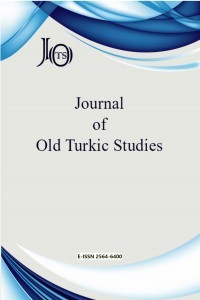Orhun Yazıtlarındaki Durum Eklerinin Sentaktik İşlevleri Üzerine
Case suffixes form various meaning relations in the sentence. The semantic and syntactic functions of the morphological aspects of the case suffixes should also be considered. These suffixes, whose actual functions appear in syntactic structure, serve as subjects, objects and complementary functions in the sentence. Orkhon inscriptions, which is one of the first written documents of Turkish, is an important source in the study of the grammatical development of the Turkish language. In order to determine the usage and functionality of the case suffixes in the historical period, the case suffixes used in the Orkhon inscriptions were examined in this study.
Anahtar Kelimeler:
case suffixes, Orkhon inscriptions, syntactic function
On the Syntactic Functions of the Case Suffixes in Orkhon Inscriptions
Case suffixes form various meaning relations in the sentence. The semantic and syntactic functions of the morphological aspects of the case suffixes should also be considered. These suffixes, whose actual functions appear in syntactic structure, serve as subjects, objects and complementary functions in the sentence. Orkhon inscriptions, which is one of the first written documents of Turkish, is an important source in the study of the grammatical development of the Turkish language. In order to determine the usage and functionality of the case suffixes in the historical period, the case suffixes used in the Orkhon inscriptions were examined in this study.
Keywords:
case suffixes, Orkhon inscriptions, syntactic function,
___
- AKSAN, D. (2009). Her Yönüyle Dil (Ana Çizgileriyle Dil Bilim) I-II, Ankara: Türk Dil Kurumu Yayınları.
- ALYILMAZ, C. (1994). Orhun Yazıtlarının Söz Dizimi, Atatürk Üniversitesi, Sosyal Bilimler Enstitüsü, Erzurum. [Yayımlanmamış Doktora Tezi]
- AYDIN, E. (2017a). Orhon Yazıtları (Köl Tégin, Bilge Kağan, Tonyukuk, Ongi, Küli Çor), İstanbul: Bilge Kültür Sanat.
- AYDIN, A. (2017b). “Köktürk Abidelerinde +Da Ekinin Kullanılış Şekilleri, Cümlelerdeki Durumları ve Fonksiyon Yükleri”, Türük Uluslararası Dil Edebiyat ve Halk Bilimi Araştırmaları Dergisi, 1/9: 1-21.
- BANGUOĞLU, T. (1990). Türkçenin Grameri, Ankara: Türk Dil Kurumu Yayınları.
- BAŞDAŞ, C. (2009). “Orhun Abidelerinde İyelik, Belirtme ve Yükleme Hâli”, Turkish Studies, 4/8: 623-643
- DALLI, H. (2018). Türkçede Söz Diziminin Yapı Birimleri, İstanbul: Papatya Yayıncılık.
- DEMİRCAN, Ö. (2005). Türkiye Türkçesinde Kök-Ek Bileşmeleri, İstanbul: Papatya Yayıncılık.
- EKER, S. (2010). Çağdaş Türk Dili, 6. Baskı, Ankara: Grafiker Yayıncılık.
- ERASLAN, K. (2000). “Eski Türkçede Yönelme (Dativ) Hali Ekinin Yapı Fonksiyon ve İfadeleri”, İstanbul Üniversitesi Edebiyat Fakültesi Türk Dili ve Edebiyatı Dergisi, 29: 67-76.
- ERDEM, M. (2015). “Türk Dillerinde Belirtme-Yönelme Durum Eki Değişmesi: Bir Değerlendirme”, Türkbilig, 30: 167-186.
- ERGİN, M. (2009). Türk Dil Bilgisi, İstanbul: Bayrak Basım Yayım Tanıtım.
- GRØNBECH, K. (2011). Türkçenin Yapısı, Çev. M. AKALIN, 3. Baskı, Ankara: Türk Dil Kurumu Yayınları.
- KERİMOĞLU, C. (2007). “Orhun Abidelerinde 3. Kişi İyelik Ekinden Sonra Yükleme Hâli Eki Kullanıldı mı?”, Turkish Studies, 2/3: 322-331.
- KORKMAZ, Z. (2011). Türkçede Eklerin Kullanış Şekilleri ve Ek Kalıplaşması Olayları, 5. Baskı, Ankara: Türk Dil Kurumu Yayınları.
- MERT, O. (2002). Kutadgu Bilig’de Hâl Kategorisi, Atatürk Üniversitesi, Sosyal Bilimler Enstitüsü, Erzurum. [Yayımlanmamış Doktora Tezi]
- ÖZDEMİR, H. (2019). “Eski Türk Yazıtlarında (Tonyukuk, Köl Tegin, Bilge Kağan, Ongi, Küli Çor) İlgi Durum Eklerinin Kullanımları ve Kökenleri Üzerine”, Karadeniz Araştırmaları, 16/61: 154-165.
- TEKİN, T. (2016). Orhon Türkçesi Grameri, Ankara: Türk Dil Kurumu Yayınları.
- ÜSTÜNOVA, K. (2012). Türkiye Türkçesi Ad İşletimi (Biçim Bilgisi), Bursa: Sentez Yayıncılık.
- Yayın Aralığı: Yılda 2 Sayı
- Başlangıç: 2017
- Yayıncı: Erdem UÇAR
Sayıdaki Diğer Makaleler
Orhun Yazıtlarındaki Er- Bar- İkilemesi Üzerine
Horezm Türkçesi ile Yazılan Kur’ân Tercümesinin Meşhed Nüshasından Bazı Parçalar (III)
The Battle of Nedao and its Importance in Eastern European Turkish History
Çağatayca Tefsir-i Hüseynî (Mevahib-i Aliyye) Tercümesi ve Farsça Dil Özellikleri Üzerine
Yeni Soylamalar ve Boylar (Hikâyeler) ile Türkmen Sahra Nüshası
